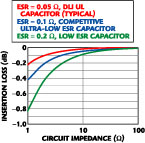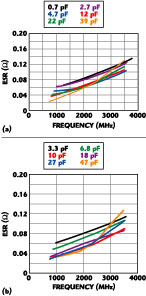A family of Ultra-low ESR products has been introduced that set a new standard for low loss microwave performance. The equivalent series resistance (ESR) is half that of previous products. The series, designated UL (Ultra-low), is currently available in both 0603 and 0505 case sizes with addition parts to follow.

Equivalent series resistance, a circuit model representation of the total loss of a capacitor, is comprised of both dielectric and metal losses. At RF and microwave frequencies metallic losses dominate. The benefits of this new UL material increase with frequency, resulting from superior electrode technology. The difference in performance is remarkable.
For high power applications, such as power amplifier matching networks, the impact of Ultra-low ESR capacitors is particularly significant as it improves gain, power, efficiency and reliability. Reliability is enhanced by the lower operating temperatures, which result from reduced power dissipation (Pdiss = Irms2 x ESR). Reduced heat translates to higher output power from the amplifier.
Low ESR brings performance enhancement to many applications in the form of:

- Higher gain, power and efficiency transmitters
- Higher reliability operation
- Lower noise figure receivers
- Lower loss antenna matching
- Lower loss T/R switches
- Increased range in wireless communications and radars
- Circuit response closer to ideal
- Filters with lower loss and improved shape
- Reduced phase noise oscillators
Any loss sensitive application will benefit from the use of Ultra-low ESR capacitors.

While ESR values of low ESR capacitors are numerically small, the impact can be much greater in high Q circuits (filters and oscillators, for example) or high power/low impedance circuits (such as power transistor matching). In a high power 50  impedance application, typical of a DC block, the reduced loss of the UL product is most evident in much lower temperature rise, as seen in Figure 1 . A comparison of the measured temperatures of DLI's Ultra-low ESR C06UL product and a 0603 Ultra-low ESR product from a competitor is shown by the data. The temperature rise for the C06UL sample is 4°C and the temperature rise of the competitive part is 12°C. The loss of the DLI C06UL part is less than half that of the competitive part. Both parts are 10 pF capacitors, mounted on a 50 mil alumina microstrip line tested at an incident power of 200 W CW at 1.8 GHz. While these temperature rise values are quite low with capacitors mounted to alumina, common printed circuit board materials would result in as much as 10 times the thermal rise pushing the competitive part into the meltdown region. These infrared images were taken after 15 minutes, long enough for thermal equilibrium to occur. The temperature color scale is the same for both parts.
impedance application, typical of a DC block, the reduced loss of the UL product is most evident in much lower temperature rise, as seen in Figure 1 . A comparison of the measured temperatures of DLI's Ultra-low ESR C06UL product and a 0603 Ultra-low ESR product from a competitor is shown by the data. The temperature rise for the C06UL sample is 4°C and the temperature rise of the competitive part is 12°C. The loss of the DLI C06UL part is less than half that of the competitive part. Both parts are 10 pF capacitors, mounted on a 50 mil alumina microstrip line tested at an incident power of 200 W CW at 1.8 GHz. While these temperature rise values are quite low with capacitors mounted to alumina, common printed circuit board materials would result in as much as 10 times the thermal rise pushing the competitive part into the meltdown region. These infrared images were taken after 15 minutes, long enough for thermal equilibrium to occur. The temperature color scale is the same for both parts.

The combination of high power and low circuit impedance levels, typical of power transistor matching, results in performance improvements to gain, power and efficiency with the DLI UL product. Figure 2 illustrates how significantly ESR impacts loss as circuit impedance levels approach a few ohms. A single DLI UL capacitor could improve amplifier performance by ~0.6 dB.
A second example of the benefit of the UL product is seen in a 2.1 GHz combline filter application, which exhibits an approximate 0.5 dB reduction in loss compared to competitive low ESR capacitors, as shown in Figure 3 .
ESR measured in the frequency range of the application is an effective means at predicting circuit losses. The performance advantage offered by UL over the other components is clear - the UL capacitors provide a typical ESR reduction of 50 percent.
Figure 4 shows the frequency dependence of ESR for the new UL capacitors compared to the company's traditional CF dielectric and a competitive "Ultra-low ESR" solution. All components are of 0603 case size, 10 pF capacitance value.
Similar data is shown for the RF/microwave industry standard 0505 case size (DLI C11 part number) devices. In this instance the new C11UL is compared to a traditional C11CF device, again demonstrating significant ESR reduction for the new device. ESR as a function of frequency and capacitance value are presented in Figure 5 for 0603 and 0505 Ultra-low ESR, UL part types.
Both part types exhibit the trend of decreasing ESR with increasing capacitance value, and set the new "gold standard" for ESR performance. Table 1 summarizes the characteristics of the C06UL and C11UL Ultra-low ESR product series.

|
Table 1 | ||
|
Characteristic |
C06UL |
C11UL |
|
Capacitance range (pF) |
0.1-47 |
0.1-100 |
|
Dissipation factor (%) |
0.05 |
0.05 |
|
ESR @ 2 GHz ( |
~0.06 |
~0.05 |
|
Insulation resistance (M |
>105 |
>105 |
|
Temperature coefficient of capacitance (ppm/°C) |
0±30 |
0±30 |
|
Voltage rating (WVDC) |
250 |
250/200 |
Conclusion
The ESR of RF/microwave frequency capacitors is an important contributor to system performance and reliability. It is a key factor in circuit loss, power capability, signal/noise performance and circuit response "perfection." Superior loss performance is demonstrated. The ultimate validation is up to the designer. Try the new UL series in your application and measure the difference for yourself. Samples are currently available and additional information may be obtained from the company's Web site at www.dilabs.com or via e-mail at sales@dilabs.com.
Dielectric Laboratories Inc., Cazenovia, NY (315) 655-8710. Circle No. 304
